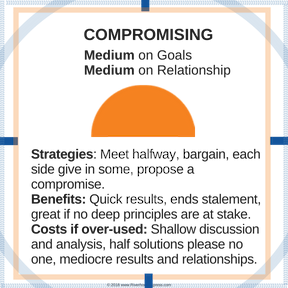 Try Using Compromising More
Try Using Compromising More 

You scored lower in Compromising in Calm settings than other styles. Consider whether you are under-using this style in early stages of conflict, when things are not yet emotional.
Of course, not using Compromising helps you avoid the pitfalls that come with the style, such as possible compromise of important values or principles, failing to examine problems in depth, or settling for "half solutions" that don't really help anyone.
But Compromising has important strengths you may be missing out on. You'll be most effective in conflict if you are good at all five styles. So increased use of Compromising might be beneficial, especially if the gap between your lowish Compromising score and your highest score in Calm is 3 or more.
Benefits of Compromising. In Compromising, you seek prompt resolution of a conflict with a solution that gives both sides some of what they want but less than their full preference. You give in a bit in return for the other side giving in a bit. Compromising is not right for every situation, but it has strong advantages:
- Speed. An acceptable compromise can often be worked out fairly quickly.
- Familiarity. The idea that "you give a little, I'll give a little" seems reasonable and helps bring out the best in people.
- Fairness. It conveys a sense of principle and moderation.
- Practicality. A compromise enables things to move on.
Ideas for Expanding Use of Compromising. Experiment with the following to get better at compromising. None is perfect for everyone; pick those that appeal to you:
- Review the costs of conflict. Compromising brings realism to conflict resolution. A low score in Compromising suggests you may benefit if you pay more attention to the costs of unresolved difficulties. This might help you accept "less than perfect" in order to resolve things and move on. If you scored high in Cooperating (in either Calm or Storm), this point is especially true, since those styles tend to come with high persistence.
- Reduce the amount of time you give to discussing and processing. A big difference between Compromising and Cooperating is that the latter invests more time in discussion and examination of options. If you tend to spend a lot of time in long discussions, experiment with setting a time limit for working out a deal. This will shift you towards compromising.
- Review priorities. Consider what else is making claims on your time and energy, in addition to the issue in conflict. Look at the conflict in this context and ask yourself where is your time and attention most needed?
- Lighten up a bit. Inability to compromise sometimes means people take every conflict as a survival test. What if you took yourself or your mission a little less seriously? What would happen if you'd smile or be mischievous?
- Expand your options; don't put all your eggs in one basket. Try to increase your alternatives for accomplishing the purposes you have in mind. This will make it easier to accept less than perfect solutions.
The other styles you scored high in are valuable - keep using them! But you may wish to experiment with getting more comfortable with Compromising, especially when a practical solution is needed quickly; or when it is important for everyone to get at least some of what they wanted.



 Need assistance? Email center@riverhouseepress.com with a copy of the login instructions you received and a brief description of what is happening. We'll reply in one business day-usually less.
Need assistance? Email center@riverhouseepress.com with a copy of the login instructions you received and a brief description of what is happening. We'll reply in one business day-usually less. 